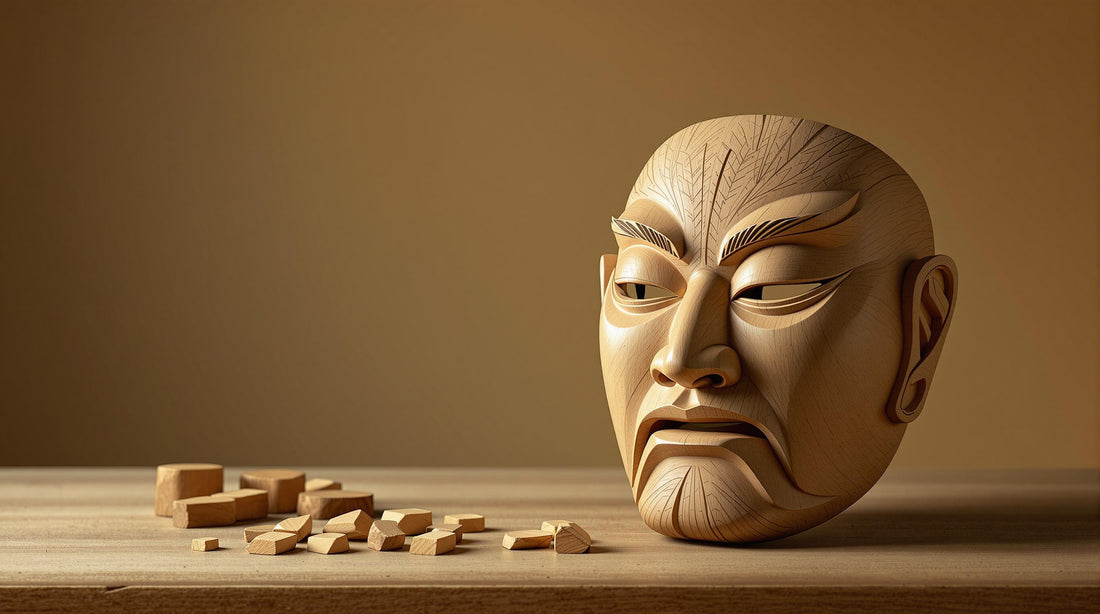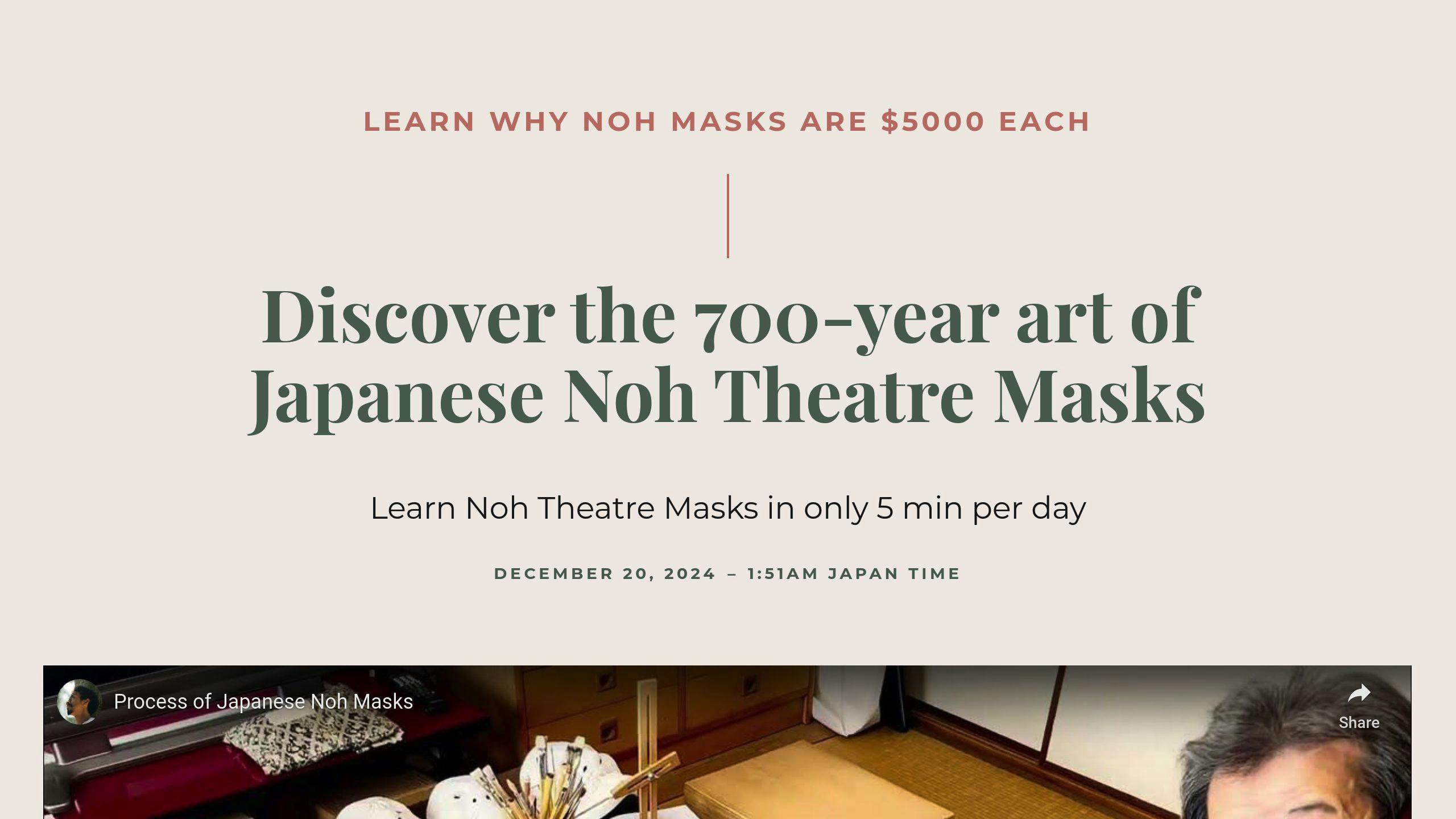
Why Hinoki Wood for Noh Masks?
Share
Hinoki wood has been the preferred material for crafting Noh masks for over 700 years. Why? Its lightweight, durable nature, smooth grain, and ability to age beautifully make it ideal for creating masks that are both functional and artistic. Here's why Hinoki wood stands out:
- Durability & Lightness: Perfect for frequent use and long performances.
- Smooth Grain: Enables precise carving and layering of traditional materials like powdered shell and glue.
- Historical Significance: Used since the Muromachi period (1333-1568), reflecting its enduring relevance in Noh theatre.
These qualities ensure that Hinoki wood masks not only last for centuries but also maintain their expressive power on stage. The article explores the crafting process, care tips, and the enduring importance of this wood in Japanese artistry.
Reasons Hinoki Wood Is Preferred
Strength and Lightness
Hinoki wood stands out for being both durable and lightweight, making it a perfect choice for Noh theatre masks. Performers need masks that can handle frequent use while remaining comfortable during long performances. Thanks to its natural toughness, Hinoki wood ensures masks can last for centuries. In fact, many masks still in use today are hundreds of years old [1].
Smooth Grain
The slow growth of Hinoki trees results in a grain structure that's ideal for carving. This smooth texture allows artisans to apply 15-20 layers of powdered shell and deer-bone glue with precision, polishing each layer to perfection [1].
Historical Use and Significance
Hinoki wood has been a key material for Noh masks since the Muromachi period (1333-1568), when Noh theatre first began. Its continued use highlights its practicality and deep cultural roots. Crafting with Hinoki wood demands immense skill and patience, reflecting its importance in this traditional art form [1][2].
The unique qualities of Hinoki wood, combined with its historical importance, make it essential for creating Noh masks.
Steps in Crafting Hinoki Wood Noh Masks
Selecting and Aging the Wood
Crafting Noh masks starts with choosing the right Hinoki wood. Artisans pick pieces based on factors like density, grain, and moisture, ensuring the wood can handle both carving and long-term use. After aging the wood to perfection, the carving phase begins, transforming the material into a work of art.
Carving and Shaping
Using tools like chisels and gouges, artisans carve the wood with incredible precision. They start by marking a basic oval outline on the block, then gradually shape features such as the nose, lips, and eyes. This detailed work can take weeks, as every detail matters. Once the features are fully formed, the mask goes through an intricate finishing process to refine its appearance.
Finalizing: Painting and Polishing
To complete the mask, artisans layer it with gofun (a white pigment), along with seashell powder, rice glue, and deer-bone glue. This process involves applying up to 15-20 coats, polishing each one to achieve a smooth, polished surface. For masks like the hannya, pigments are applied with care to amplify their striking expressions.
Master artisans like Mitsue Nakamura continue to uphold the craftsmanship and quality that have defined Noh theatre masks for generations [2].
Maintaining Hinoki Wood Noh Masks
Storage and Conditions
Storing Hinoki wood Noh masks correctly is essential to keep them in good condition. These masks are delicate and need specific conditions to avoid damage. Use traditional Japanese boxes, which let the wood breathe while shielding it from temperature and humidity fluctuations.
| Storage Factor | Recommended Conditions |
|---|---|
| Temperature | 15-20°C (59-68°F) |
| Humidity | 40-60% |
| Light Exposure | Minimal indirect light |
| Storage Container | Traditional Japanese boxes |
Keep the temperature between 15-20°C (59-68°F) and humidity levels at 40-60%. Avoid placing masks near heat sources, direct sunlight, or damp areas, as these can cause warping or discoloration.
Handling and Repair
Always wear clean cotton gloves when handling Noh masks, and support them from both sides to avoid accidental damage. Regularly inspect the masks, ideally every 6-12 months, for the following issues:
- Cracks on the wood surface
- Warping or splitting
- Fading or damage to paint or lacquer
- Areas of discoloration
If you notice any damage, consult a professional artisan skilled in traditional Japanese mask restoration. These experts use time-honored techniques to repair the masks while preserving their original craftsmanship. Avoid using modern cleaning products or abrasive materials, as they can harm the wood and paint.
For collectors looking for professional care, resources like Noh Theatre Masks can help connect you with experienced artisans. By following these care tips, you can protect the artistry and legacy of Noh masks, ensuring they remain cherished pieces for generations to come.
sbb-itb-e829fd7
The Process of Making Traditional Noh Masks
Conclusion: The Enduring Value of Hinoki Wood for Noh Masks
For over 700 years, Hinoki wood has played a central role in the creation of Noh masks, thanks to its unmatched qualities. This wood undergoes decades of careful preparation, making it perfect for carving durable and expressive masks. Its unique characteristics allow artisans to craft masks that are not only functional but also carry deep artistic significance [1].
When properly lit and positioned, Hinoki masks can convey a wide spectrum of emotions, a critical feature in Noh performances. This connection between the material and the art highlights the importance of supporting the craftspeople who dedicate their lives to this tradition.
Supporting Artisans
The future of Noh mask-making depends on the skilled artisans who preserve and refine these age-old techniques. Experts like Mitsue Nakamura continue to uphold the highest standards in their craft [2].
If you’re passionate about preserving this art form, here are some ways to help:
- Explore museum collections, such as those at the Kyoto Museum of Traditional Crafts.
- Attend live Noh performances to support the theater community.
- Purchase authentic masks directly from master artisans.
- Enroll in educational programs to learn more about the craft.
Noh Theatre Masks: Connecting with Tradition

Noh Theatre Masks serves as a bridge between enthusiasts and artisans, offering interviews, insights, and authentic masks crafted for performers. By sharing stories from artisans like Torihata-san, the platform provides a rare glimpse into the world of Noh mask creation, ensuring these traditional techniques are celebrated and passed on to future generations.
FAQs
How are noh theatre masks made?

Creating Noh masks is a detailed process that combines artistry and tradition. It typically involves three main steps: carving, shaping, and finishing.
Artisans start with Hinoki wood, prized for its smooth texture and lightweight nature - perfect for the detailed carving and long-lasting durability these masks require.
The finishing touches rely on traditional Japanese materials like gofun (powdered shell), nikawa (animal glue), and iwa-enogu (mineral pigments). Over the course of about a month, multiple layers are carefully applied and polished to achieve the final look [1].
This level of craftsmanship ensures that each mask is not just functional but also a lasting piece of art. The choice of Hinoki wood plays a key role in ensuring the masks remain expressive and durable for generations [1].
